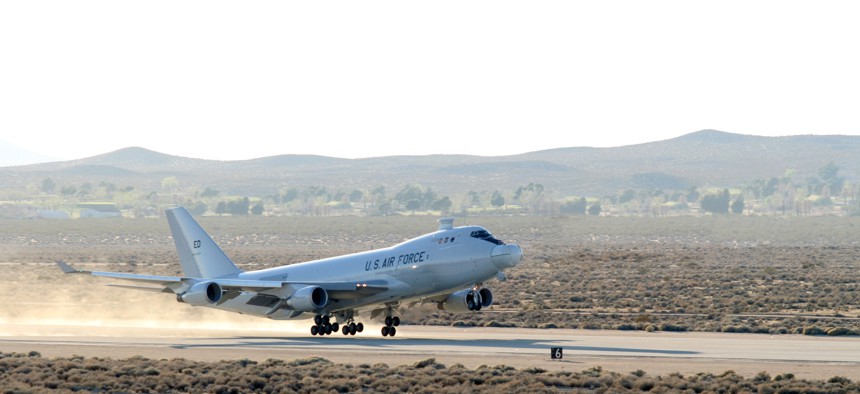
The YAL-1A Airborne Laser, a modified Boeing 747-400F, takes off from Edwards Air Force Base, California, on March 15 for a five-hour test mission. United States Air Force photo by Kellie Masters
Pentagon Eyes Laser-Armed Drones to Shoot Down Ballistic Missiles
The high-flying aircraft would be the unmanned successors to the Air Force’s missile-zapping jetliner.
Four years after the Air Force’s missile-zapping Boeing 747 went to its final resting place in the Arizona desert, the Pentagon is thinking anew about airborne lasers that shoot down ballistic missiles. This time, they’d be mounted on smaller, higher-flying drones.
The idea has been around for decades, but the Pentagon’s missile defense chief says its time may have come. The plan is to see how the laser technology matures over the next three years to fit it on a high-altitude drone, Vice Adm. James Syring, the Missile Defense Agency director, said Tuesday.
“We have significantly ramped up our program in terms of investment and talking about it more of what else needs to be done to mature this capability,” Syring said at a Center for Strategic and International Studies event in Washington.
Such drones would be designed to fly at 65,000 feet or higher, far above bad weather. They would stay aloft for days, even weeks, loitering around launch sites so they could fire upon enemy missiles as they lift off.
The military has long sought a way to get at ballistic missiles in their vulnerable “boost phase,” drawing a bead on them before they reach full speed, deploy decoys, or take evasive action. The Pentagon spent 16 years and $5 billion building the Airborne Laser, a heavily modified Boeing 747 jetliner with a bulbous chemical laser on its nose. In 2010, it shot down a missile in a test.
“It proved that this this concept could work,” Syring said. “It proved that, given enough power, given enough beam quality, given enough altitude, intercept of a ballistic missile … [at a] wide variety of ranges would theoretically be possible.”
But the Airborne Laser’s short range required it to be so close to a launch site that it would expose itself to enemy fighter jets or ground fire. And providing round-the-clock defense would have required small fleets of 747s plus fighter jets for protection and tanker aircraft to keep everything fueled up.
Then there was the laser itself. Powered by chemicals, the laser and its support equipment was comparable in size and weight to six Chevrolet Suburban SUVs. Each time the laser was fired, the plane would need to land to have its chemicals refueled.
It was “hard to maintain a chemical laser,” Syring said.
Pentagon officials have therefore focused their attention on other types of lasers that are lethal at longer ranges and that can be fired several times a flight. The challenge is getting more power from lighter-weight lasers.
“You’re going to need as much power as you can get to destroy as many boosters as you can,” Syring said. “If you can balance that range, altitude, power and number of boosters you need to defeat to help augment our kinetic capability, you’re thinking about the problem exactly right.”




